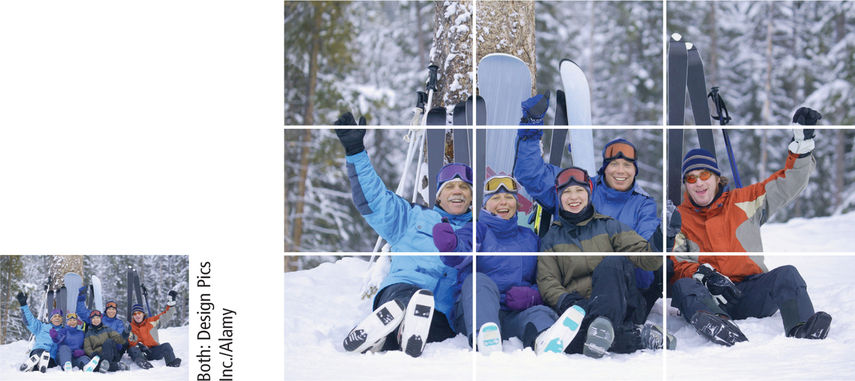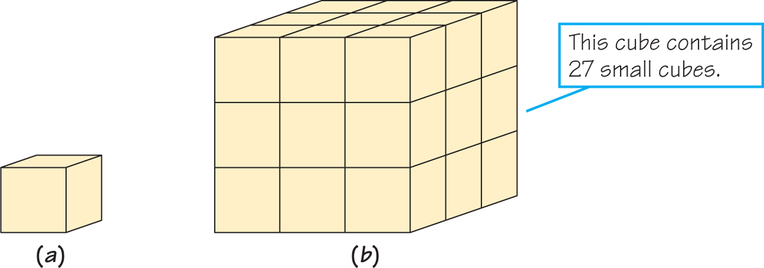18.2 18.1 Geometric Similarity
We use the powerful mathematical concept of geometric similarity. You may have encountered this idea in geometry in connection with similar triangles (see Figure 18.2). Here we apply it to real objects.

Geometric Similarity DEFINITION
Two objects are geometrically similar if they have the same shape, regardless of the materials of which they are made; they do not have to be the same size.
Although similar objects need not be the same size, corresponding distances must be proportional, just as in similar triangles. For example, when a photo is enlarged, it is enlarged by the same factor in both the horizontal and vertical directions—in fact, in any direction (such as a diagonal). We call this magnification factor the linear scaling factor (or length scaling factor).
Linear (Length) Scaling Factor DEFINITION
The linear (length) scaling factor of two geometrically similar objects is the ratio of a length of any part of the second to the corresponding part of the first.
In Figure 18.3, the linear scaling factor is 3; the enlargement is 3 times as wide and 3 times as high as the original. In fact, every pair of points becomes 3 times as far apart.
Objects can be scaled down as well as up; for example, the smaller photograph in Figure 18.3 is geometrically similar to the larger one. The linear scaling factor to get the smaller from the larger is 1/3.

How Area and Volume Scale
The enlargement can be divided into 3×3=9 rectangles, each the size of the original. Hence, the enlargement has 3×3=32=9 times the area of the original. More generally, if the linear scaling factor is some general number L (not necessarily 3), the resulting enlargement has an area L×L=L2 (“L squared”) times the area of the original.
Area Scaling Factor DEFINITION
The area scaling factor of two geometrically similar objects is the ratio of the area of any part of the second to the corresponding part of the first.
How Area Scales RULE
The area of a scaled-up object goes up in proportion to the square of the linear scaling factor.
We symbolize the relationship between the area A and the linear scaling factor L by
A∝L2
where the symbol ∝ is read as “is proportional to” or “scales as.”
What about enlarging three-dimensional objects? If we take a cube and enlarge it by a linear scaling factor of 3, it becomes 3 times as long, 3 times as high, and 3 times as deep as the original (see Figure 18.4).

What about volume? How much bigger is the volume of the enlarged cube? The enlarged cube has three layers, each with 3×3=9 little cubes, each the same size as the original. Thus, the total volume is 3×3×3=33=27 times as much as the original cube. Denoting the volume by V, we can write
V∝L3
Thus, for an object enlarged or shrunken by a linear scaling factor L, the resulting volume is L×L×L=L3 (“L cubed”) times the volume of the original. Like the relationship between area and L2, this relationship holds even for irregularly shaped objects, such as science-fiction monsters.
Volume Scaling Factor DEFINITION
The volume scaling factor of two geometrically similar objects is the ratio of the volume of any part of the second to the corresponding part of the first.
How Volume Scales RULE
The volume of a scaled-up object goes up in proportion to the cube (third power) of the linear scaling factor.
You can see, however, that the area of each face (side) of the enlarged cube is 32=9 times as large as that of a face of the original cube, just as the area of the photo enlarged by a factor of 3 has 9 times the area of the original. The total surface area of the enlarged cube is 9 times the total surface area of the original cube.
More generally, for objects of any shape, the total surface area of a scaled-up object goes up with the square of the linear scaling factor. Thus, the surface area of an object scaled up by a linear scaling factor of L is L2 times the surface area of the original. This feature holds true even for irregular shapes.
Before we discuss scaling real three-dimensional objects, you should understand some language pitfalls in describing increases and decreases.
The Language of Growth, Enlargement, and Decrease
Let’s see if you can make sense of some incorrect and confusing claims you can find on the Internet:
1 out of 3 households earned 200 percent less than the poverty line in 2009.
—inthesetimes.com/working/entry/6793/since_great_recession_more_working_families_in_poverty
Well, 50% less than would be half as much, 100% less than would be zero, and 200% less than simply makes no sense. But here it’s just that the word order is mixed up. What the writer meant to say is “earned less than 200% of the poverty line.”
Americans … bike 25 times less than the Dutch.
—cleantechnica.com/2014/01/03/americans-drive-twice-much-brits-bike-25-times-less-dutch/
You no doubt guess that “25 times less” really means “one twenty-fifth” as much. But the latter doesn’t sound as grand. Writing “25 times” does give the correct ratio, and “less” clues the reader about which is less. But mixing “times” with “less” or “more” offers potential for confusion, as you can see in the following example.
At a website giving information about federal student loans, you may find the following statement:
Under this plan, your monthly payments … won’t be more than three times greater than any other payment.
Let’s see. Suppose you have $1. If I have $1 greater than what you have, then I have $2. If I have $3 greater than what you have, then I have … $4.
The terms more, larger, and greater refer to adding to the original amount. The terms times and twice as much as refer to multiplication of the original amount. For instance, if you have $1 and I have “5 times as much,” then I have $5—which is $4 more than you have, hence “4 times more than” what you have (the original plus 4 times as much).
What we have in the loan information is a mixing of additive and multiplicative terms, and it is not clear what is meant. Further investigation reveals that what was intended was “no more than 3 times your lowest payment.” Using times together with more or greater than is, to use a football analogy, “piling on.” It is often designed to impress the audience by attempted exaggeration.
The relationship of an original amount to a larger amount can be expressed either in multiplicative terms (“one-fifth as much” or “20% as much”) or in subtractive terms (“four-fifths less than” or “80% less than”)—but don’t mix the two.
Texting while driving is the number one cause of death for American teenagers. What is wrong with the following claim, and how could you state it correctly?
Texting drivers looked at the road 400 percent less than drivers who did not text message while behind the wheel of a car.
—carlsbad.patch.com/groups/michael-bombergers-blog/p/bp-the-dangers-of-texting-while-driving
If we follow the same logic of the writer of the claim about American and Dutch cycling, we would conclude that texters look at the road one-fourth as much as non-texters. But we would be wrong; tracing this phrase to its original source (in Australia in 2006), we find:
Drivers spent up to 400 percent more time with their eyes off the road when text messaging, than when not text messaging…. The amount of time that drivers spent with their eyes off the road increased by up to 400% when retrieving and sending text messages.
This phrasing would mean that texters spent 5 times as much time with their eyes off the road as non-texters; or put another way, non-texters had their eyes off the road one-fifth as often as non-texters. But alas! The details of the report reveal that non-texters spent 10% of the time with their eyes off the road and texters spent 40% (aargh!). So the phrasing by the report writers and the “interpretation” of it by the blogger are both misleading. We could correctly talk about “4 times as much” or “300% more” or “one-fourth as much” or “25% as much” or “75% less”—as long as we don’t mix up additive and multiplicative terminology.
EXAMPLE 1 Generic Medicines
Generic Medicines
What is wrong with the following claim, and how would you state it correctly?
Most generic medications aren’t 50% or 75% less expensive than their brand named equivalents, they are 100 times cheaper!!
—David Belk, The True Cost of Healthcare A View of Healthcare Costs from the Inside, www.truecostofhealthcare.org
The claim was rephrased (by another pair of doctors) as the following:
Generic medications can cost 100 percent less than their brand-name equivalent.
What’s wrong with that claim?
The first claim mixes “times” with a form of “more.” The second claim would indicate that generic medicines cost nothing. Correct versions of the statements would be: “Generic medicines cost 1% as much as their brand-name equivalents” and “Brand-name medicines cost 100 times as much as their generic equivalents.”
Self Check 1
What’s wrong with the following claim, and how would you state it correctly?
Will the U.S. women’s world champion soccer team really get paid 40 times less than the men?
—David Muir, ABC World News Tonight, 7 July 2015
- Nothing can be 40 times less than another quantity. Correct: The men are paid 40 times as much as the women; the women are paid one-fortieth as much as the men (in salaries from their pro teams).
People often say “5 times more than” when they mean “5 times as much.” All you can do is be aware of the potential confusion, try to figure out what was meant, and be careful in your own expression.
Correct Comparisons RULE
Don’t use times with more or with less.
Finally, we need to distinguish percent from percentage points: If support for the president decreased from 60% to 30%, it dropped 30 percentage points but decreased 50% (because the drop of 30 percentage points is 50% of the original 60 percentage points).